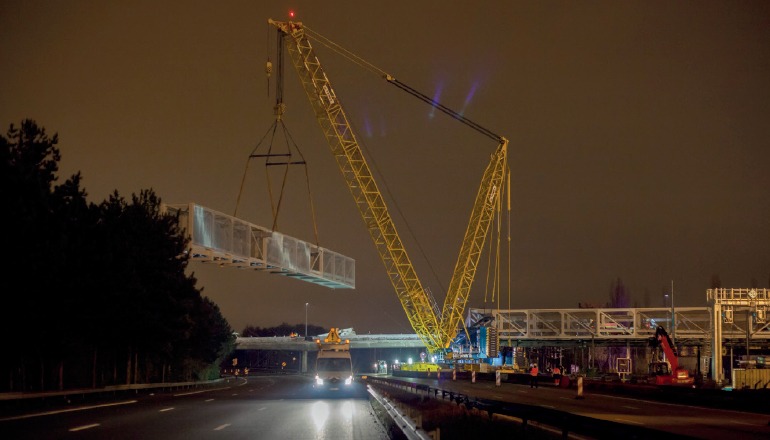Yet another great crane shot, this time a Terex Superlift 3800 crawler crane lifting a bridge over a French highway by a Belgium company called Sarens.
The lattice boom crawler crane was employed to lift a pedestrian and bicycle steel bridge over the A4 Autoroute near Schiltigheim, in Alsace.
The project’s conditions were unique. “We didn’t have a special permit for a heavy-load transport with the required weight,” says Sarens project manager Joost Elsen. “That meant that we first had to figure out how exactly we’d be able to get a crane with the necessary lifting capacity to the site.”
The crane made it possible to overcome this challenge with a special feature that is called “Quick Connection” by the manufacturer. This feature makes it possible to disassemble the crane’s basic structure into two parts in order to significantly reduce the weights involved in transporting the machine. A total of 56 transport vehicles were required, and these vehicles faced an adverse situation of their own: Since the access road to the site was extremely narrow, the trucks had to drive on a gravel road for about a kilometre, in reverse and one by one, before reaching the spot where the crane would be set up.
Despite this time-consuming procedure, the Sarens team was able to get the Superlift 3800 crane ready on time with four assembly technicians and the crane operator. “The crane’s ease of assembly literally paid for itself in this case,” Elsen says. In order to affect traffic as little as possible, the lift was performed at night.
For the lift, the Sarens technicians set up the Superlift 3800 crane with an SSL1 configuration, a 54-metre main boom, and 325 tonnes of Superlift counterweight so that the machine would be able to pick up the bridge section at a working radius of 40 metres.
In order to prevent the 65-metre-long and 350-metre-wide load from swinging around when lifted, it was slung to a perfectly balanced spreader. This enabled crane operator Michael Bräckle to safely lift the component to a height of 20 metres.
After this, the main boom was raised in order to reduce the working radius to 29 metres so as to be able to lower the Superlift counterweight radius from 18 to 11 metres. With this compact configuration, the crane was able to turn 180 degrees within its tight working area and swing the bridge over the highway.
“To do this, we used the crane’s Vario Superlift system, which was developed precisely for this kind of scenario – a clever idea from Terex,” says crane operator Bräckle when praising the feature. Once the bridge was swung over the highway, the crane moved forward about 12 metres under load. When the crane had reached its final destination, the main boom was brought down and the Vario system was used to bring the SL counterweight back to a radius of 18 metres. Finally, the bridge section was lowered onto the bridge piers at the original working radius of about 40 metres.
“We would have never been able to do this job without the Superlift 3800. Without the Quick Connection feature, we wouldn’t have been able to get a machine that was powerful enough to the site, and without the Vario Superlift system, there wouldn’t have been enough space for the lift. In fact, these are perfect examples of the technological ingenuity behind the Superlift 3800 that won us over from the start. That’s why we have three of them in our fleet,” Elsen says.


Parting words from Jeremy Sole- a final column